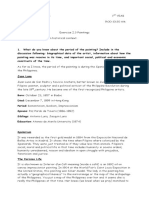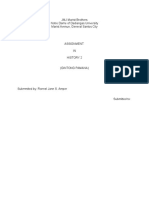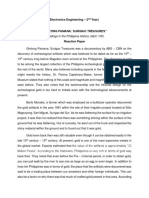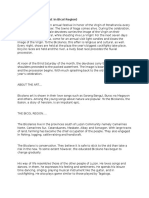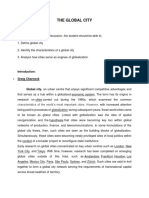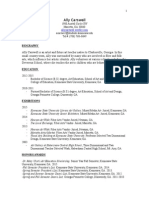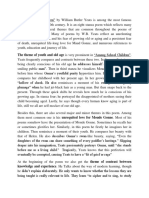Professional Documents
Culture Documents
Hidalgo
Hidalgo
Uploaded by
DanayaCaneshca0 ratings0% found this document useful (0 votes)
702 views2 pagesFélix Resurrección Hidalgo's 1884 painting "Christian Virgins Exposed to the Populace" depicts two scantily clad Christian slave women being mocked by Roman men. The painting won a silver medal at an exhibition in Madrid, Spain. It is considered one of the Philippines' national treasures and is known for highlighting the persecution of early Christians and the vulnerability of its female subjects. Along with another famous Philippine painting, it featured themes of human exploitation to satisfy the scholarly tastes of its European audience.
Original Description:
i need rizal's stay in japan for my project
Copyright
© © All Rights Reserved
Available Formats
DOCX, PDF, TXT or read online from Scribd
Share this document
Did you find this document useful?
Is this content inappropriate?
Report this DocumentFélix Resurrección Hidalgo's 1884 painting "Christian Virgins Exposed to the Populace" depicts two scantily clad Christian slave women being mocked by Roman men. The painting won a silver medal at an exhibition in Madrid, Spain. It is considered one of the Philippines' national treasures and is known for highlighting the persecution of early Christians and the vulnerability of its female subjects. Along with another famous Philippine painting, it featured themes of human exploitation to satisfy the scholarly tastes of its European audience.
Copyright:
© All Rights Reserved
Available Formats
Download as DOCX, PDF, TXT or read online from Scribd
Download as docx, pdf, or txt
0 ratings0% found this document useful (0 votes)
702 views2 pagesHidalgo
Hidalgo
Uploaded by
DanayaCaneshcaFélix Resurrección Hidalgo's 1884 painting "Christian Virgins Exposed to the Populace" depicts two scantily clad Christian slave women being mocked by Roman men. The painting won a silver medal at an exhibition in Madrid, Spain. It is considered one of the Philippines' national treasures and is known for highlighting the persecution of early Christians and the vulnerability of its female subjects. Along with another famous Philippine painting, it featured themes of human exploitation to satisfy the scholarly tastes of its European audience.
Copyright:
© All Rights Reserved
Available Formats
Download as DOCX, PDF, TXT or read online from Scribd
Download as docx, pdf, or txt
You are on page 1of 2
Christian Virgins Exposed to the Populace
Flix Resurreccin Hidalgo
Las Virgenes Cristianas Expuestas al Populacho or The Christian Virgins
Exposed to the Populace is a famous 1884 history painting by Filipino painter, reformist,
and propagandist Flix Resurreccin Hidalgo. The painting is alternately known
as The Christian Virgins Exposed to the Rabble, Jovenes Cristianas Expuestas al
Populacho (Christian Maidens Exposed to the Populace), Christian Virgins Presented to
the Populace, The Christian Virgins Being Exposed to the Populace, and Christian
Virgins Exposed to the Mob.
The painting was a silver medalist (ninth silver medal award among fortyfiveduring the 1884 Exposicion General de Bellas Artes in Madrid, Spain, also known as
the Madrid Exposition. According to Raquel A.G. Reyes, Hidalgo's winning the silver
medal for the painting was a landmark achievement that proved the ability of Filipinos to
match the work of Spaniards and laid claim to Filipino participation in European culture.
Regarded as one of the national treasures of the Philippines, a copy of the
painting is currently housed at the Philippine's Metropolitan Museum of Manilaand a part
of the art collection of the Bangko Sentral ng Pilipinas (Central Bank of the Philippines).
The original was destroyed in a fire at the University of Valladolid in Spain.
Description
An oil on canvas painting measuring 1.15 m 1.57 m (45 62 in), Las Virgenes
Cristianas Expuestas al
Populacho is a
"landmark painting"
depicting
the persecution ofChristians in Ancient Rome. Described as a masterpiece remarkable
in the aspects of quality, composition, and historical context, it portrays two scantily
clothed Christian female slaves being mocked by a group of boorish Roman male
onlookers. One of the women is posed seated naked at the foreground of the painting
with her "head bowed in misery". The semi-nude women have been stripped not only of
their garments but also of their dignity. Created in the academic style of Europe, the
unfortunate women in the artwork are considered by some indigenous Filipinos as
virgins "being led out, stolen from, and ridiculed".The women are young virgins cornered
by a mob of "sexually hungry" Roman men. One of the men has his hand over one
semi-naked female whose eyes are "looking up to heaven" asking and begging for "help
that never comes".
Together with Juan Luna's Spoliarium, Hidalgos Las Virgenes Cristianas Expuestas al
Populacho presents "human spoliage and spoils", with human spoilage more related to
Luna's Spoliarium and the human spoils closer to Hidalgo's Las Virgenes Cristianas
Expuestas al Populacho. Such themes were presented to the "juries and audiences" of
the Madrid exposition in order to satisfy the "erudition-quotient" essential to the
conservative scholarly Neoclassicism of Hidalgo and Luna while they were spending
time in Europe.
You might also like
- Should Students of Politics Seek To Be Objective and Politically NeutralDocument4 pagesShould Students of Politics Seek To Be Objective and Politically NeutralEJ Bangcong50% (2)
- Spells For Healing and UnhexingDocument7 pagesSpells For Healing and Unhexingtower188% (26)
- Historical Development of Philippine ArtsDocument3 pagesHistorical Development of Philippine ArtsKino SuettanoNoch keine Bewertungen
- Rizal (M2L1)Document3 pagesRizal (M2L1)Louise BattadNoch keine Bewertungen
- The Web of Myth TheoryDocument7 pagesThe Web of Myth TheoryTeodora ArtimonNoch keine Bewertungen
- 63 Great African Design Symbols and AdinkraDocument26 pages63 Great African Design Symbols and AdinkraOrockjoNoch keine Bewertungen
- Youens, Excavating An Allegory Pierrot Lunaire Texts (JASI 8-2, 1984)Document11 pagesYouens, Excavating An Allegory Pierrot Lunaire Texts (JASI 8-2, 1984)Victoria Chang100% (1)
- Spoliarium: The Analogy of Dead GladiatorsDocument5 pagesSpoliarium: The Analogy of Dead GladiatorsKate Magpayo50% (2)
- My Reflection: Maverick RicaldeDocument1 pageMy Reflection: Maverick RicaldeAllen ElguiraNoch keine Bewertungen
- Exercise 2.3Document2 pagesExercise 2.3Almavilla BantayanNoch keine Bewertungen
- Renato ConstantinoDocument12 pagesRenato ConstantinoEmerson Fernandez100% (1)
- Context of Pigafetta and Plasencia DocumentsDocument21 pagesContext of Pigafetta and Plasencia DocumentsKyledana Francisco33% (3)
- Art Appreciation: Ms. Glaidel C. Dela Cruz, LPTDocument25 pagesArt Appreciation: Ms. Glaidel C. Dela Cruz, LPTmysterioushumane100% (1)
- Content Presentation and Analysis of The Important Historical InformationDocument2 pagesContent Presentation and Analysis of The Important Historical InformationKyle Patrick MartinezNoch keine Bewertungen
- Artworks PDFDocument12 pagesArtworks PDFVanessa Red100% (4)
- Untitled (Palay Maiden) : Why This Is ADocument3 pagesUntitled (Palay Maiden) : Why This Is AKatherine Canisguin AlvarecoNoch keine Bewertungen
- The Parisian LifeDocument2 pagesThe Parisian LifeThea Marie Ariate100% (1)
- The Philippines A Century HenceDocument2 pagesThe Philippines A Century HenceFrancine NavaNoch keine Bewertungen
- Philippines TreasureDocument2 pagesPhilippines TreasureJohn Aaron TamayoNoch keine Bewertungen
- Reflection ArtDocument4 pagesReflection ArtDianaNoch keine Bewertungen
- Antonio Pigafetta. First Voyage Around The World, (Pp. 23-48) (Chronicle)Document5 pagesAntonio Pigafetta. First Voyage Around The World, (Pp. 23-48) (Chronicle)Christian ComotNoch keine Bewertungen
- The Contemporary World M6T4Document13 pagesThe Contemporary World M6T4joint accountNoch keine Bewertungen
- Spolarijum ReportDocument3 pagesSpolarijum ReportTimothy James Bascos ValdevillaNoch keine Bewertungen
- Case Study: History 21: Readings in Philippine HistoryDocument24 pagesCase Study: History 21: Readings in Philippine HistoryIrah LafortezaNoch keine Bewertungen
- RRL DraftDocument6 pagesRRL DraftKaryl Mae Bustamante OtazaNoch keine Bewertungen
- Activity #2 History With LourdDocument3 pagesActivity #2 History With LourdCK CastilloNoch keine Bewertungen
- Readings in Philippine HistoryDocument12 pagesReadings in Philippine Historylalisa kimNoch keine Bewertungen
- Act4 G2 RizalDocument3 pagesAct4 G2 RizalKeneth Joe CabungcalNoch keine Bewertungen
- The First Cry of The RevolutionDocument1 pageThe First Cry of The RevolutionSORENI SORENINoch keine Bewertungen
- JMJ Marist Brothers Notre Dame of Dadiangas University Marist Avenue, General Santos CityDocument3 pagesJMJ Marist Brothers Notre Dame of Dadiangas University Marist Avenue, General Santos Cityronnel amper0% (1)
- Module 8 - Dr. Jose Rizal's Literary WorksDocument6 pagesModule 8 - Dr. Jose Rizal's Literary WorksNeshra Delynie TorresNoch keine Bewertungen
- AH Lesson 6 The Philippines 7100 Island One Common VoiceDocument32 pagesAH Lesson 6 The Philippines 7100 Island One Common VoiceMarlou Castro AnteñeroNoch keine Bewertungen
- RIPH - Summary of Week 7 11Document7 pagesRIPH - Summary of Week 7 11Denise Rina de GuzmanNoch keine Bewertungen
- Katips ReflectionDocument2 pagesKatips ReflectionHoney Lou Semblante0% (1)
- Analysis of The Political Caricature During The American PeriodDocument3 pagesAnalysis of The Political Caricature During The American PeriodVenus SalgadoNoch keine Bewertungen
- The Silk Road HI16 Reflection PaperDocument5 pagesThe Silk Road HI16 Reflection PaperkiwimimiiNoch keine Bewertungen
- Ang Dapat Mabatid NG Mga TagalogDocument4 pagesAng Dapat Mabatid NG Mga TagalogLyannah Rizch BlanqueraNoch keine Bewertungen
- 03Document1 page03Christine AnunciadoNoch keine Bewertungen
- Sa Ngalan NG TuboDocument1 pageSa Ngalan NG TuboVictoria FuentesNoch keine Bewertungen
- Lee Andre NillamaDocument2 pagesLee Andre NillamaLee NillamaNoch keine Bewertungen
- Some Notable Filipino Artists (PARADO)Document4 pagesSome Notable Filipino Artists (PARADO)Juzz Casiano ParadoNoch keine Bewertungen
- Riph ActivityDocument2 pagesRiph ActivityDanelle ObañaNoch keine Bewertungen
- Santos, Aira Kristelle M. - The Declaration of Indepence of The Filipino PeopleDocument5 pagesSantos, Aira Kristelle M. - The Declaration of Indepence of The Filipino PeopleAi MendozaNoch keine Bewertungen
- El Presidente (Film) - WikipediaDocument36 pagesEl Presidente (Film) - WikipediaNick Jargon Pollante NacionNoch keine Bewertungen
- 1.sociocultural Impact in Bicol RegionDocument3 pages1.sociocultural Impact in Bicol RegionCzareena KwonNoch keine Bewertungen
- Alimpia I AB1Document2 pagesAlimpia I AB1Yvette Hannah AlimpiaNoch keine Bewertungen
- Balintawak Points PDFDocument2 pagesBalintawak Points PDFMark SupsupinNoch keine Bewertungen
- What Is The Significance of Tearing of The Cedulas? What Did The Cedulas Signify?Document2 pagesWhat Is The Significance of Tearing of The Cedulas? What Did The Cedulas Signify?Donita Binay67% (3)
- Art in Early Civilization 2Document2 pagesArt in Early Civilization 2ANGEL ESTRADANoch keine Bewertungen
- Topic 2B Abridged Tejeros ConventionDocument6 pagesTopic 2B Abridged Tejeros ConventionCindy-chan DelfinNoch keine Bewertungen
- Module 6, James Lorie S. Leala S411Document2 pagesModule 6, James Lorie S. Leala S411Marlon CastilNoch keine Bewertungen
- Sa Duyan NG SiningDocument3 pagesSa Duyan NG Siningheize resente50% (4)
- Ate Ai Reaction PaperDocument2 pagesAte Ai Reaction PaperMaria Olivia Dela VegaNoch keine Bewertungen
- Mendiola Massacre Statement 2015Document3 pagesMendiola Massacre Statement 2015Sheryl Alapad100% (1)
- Rizal's Formal Schooling at A Village SchoolDocument12 pagesRizal's Formal Schooling at A Village SchoolLove Joey50% (2)
- M3 Post Task: Critical ThinkingDocument1 pageM3 Post Task: Critical Thinking24 PAULINO ALDRIN MUJARNoch keine Bewertungen
- Famous Painters and Their WorksDocument7 pagesFamous Painters and Their WorksCherry Brutas100% (1)
- This Study Resource Was: Jun Zen Ralph V. Yap BSA - 2 Year Activity 8Document3 pagesThis Study Resource Was: Jun Zen Ralph V. Yap BSA - 2 Year Activity 8John Carl B. Aparicio100% (1)
- Felix Resurrecion Hidalgo's El Asesinado Del Gobernador Bustamante (The Assassination Governor Bustamante) Also Known As La Iglesia Contra El Estado (The Church Against The State) A CritiqueDocument3 pagesFelix Resurrecion Hidalgo's El Asesinado Del Gobernador Bustamante (The Assassination Governor Bustamante) Also Known As La Iglesia Contra El Estado (The Church Against The State) A CritiqueJoaquin G. Manalo100% (2)
- The Global City Final 0.001Document6 pagesThe Global City Final 0.001Jade SagarioNoch keine Bewertungen
- CONTEMP - W - GAYETA - Opinion EssayDocument2 pagesCONTEMP - W - GAYETA - Opinion EssayJANINE VICTORIA GAYETANoch keine Bewertungen
- Cry of Balintawak or PugadlawinDocument3 pagesCry of Balintawak or PugadlawinLovely Faith PelleteroNoch keine Bewertungen
- Kartilya NG KatipunanDocument5 pagesKartilya NG KatipunanScott Woodrow Suganob100% (1)
- Filipino Spanish Times Painters/ArtistsDocument4 pagesFilipino Spanish Times Painters/ArtistsMian NakaharaNoch keine Bewertungen
- Karnataka Film 6.4.2017 FinalDocument60 pagesKarnataka Film 6.4.2017 FinalVinayak GuptaNoch keine Bewertungen
- Sacred Places in Navoi RegionDocument5 pagesSacred Places in Navoi RegionresearchparksNoch keine Bewertungen
- Dan A. Hays, A Senior Fellow at The Xerox Corporation's Wilson Center For Research and Technology, ExplainsDocument1 pageDan A. Hays, A Senior Fellow at The Xerox Corporation's Wilson Center For Research and Technology, ExplainsprakxajNoch keine Bewertungen
- Social Media ImpactsDocument2 pagesSocial Media Impactsapi-509995362Noch keine Bewertungen
- Q1 Grade 7 ARTS DLLDocument14 pagesQ1 Grade 7 ARTS DLLJhustin Castro Agustin67% (3)
- Call Me by Your Name: A.) Literary Text AnalysisDocument3 pagesCall Me by Your Name: A.) Literary Text AnalysisRod NajarroNoch keine Bewertungen
- CV Biographical ReviewDocument3 pagesCV Biographical ReviewOscar Mauricio Carrillo ViverosNoch keine Bewertungen
- Roofing Terminology: S&K Roofing, Siding and Windows Aims To Be Your Roofing Resource in MD & VADocument2 pagesRoofing Terminology: S&K Roofing, Siding and Windows Aims To Be Your Roofing Resource in MD & VAOnuoha ChiemezieNoch keine Bewertungen
- Flying Buffalo - Citybook VI - Up Town PDFDocument98 pagesFlying Buffalo - Citybook VI - Up Town PDFВячеслав0% (1)
- Experience: Lauren McconnellDocument1 pageExperience: Lauren McconnellKyuoko TsugameiNoch keine Bewertungen
- David Adams - Organic Funcionalism (Paper)Document18 pagesDavid Adams - Organic Funcionalism (Paper)Roger Krieger100% (1)
- Ally Carswell ResumeDocument3 pagesAlly Carswell Resumeapi-240165828Noch keine Bewertungen
- Lysaght Webinar - Episode 2 - The Sarawak Museum - PPTDocument37 pagesLysaght Webinar - Episode 2 - The Sarawak Museum - PPTgilbert850507Noch keine Bewertungen
- 8 Questions Using WhatDocument3 pages8 Questions Using Whatrico16022813Noch keine Bewertungen
- Onepointperspective QuizDocument1 pageOnepointperspective Quizapi-267697297Noch keine Bewertungen
- Subject Pronouns and Possessive Adjectives Exercises - AnswersDocument5 pagesSubject Pronouns and Possessive Adjectives Exercises - AnswersloricickNoch keine Bewertungen
- Sayali Bhagat: Neetu ChandraDocument4 pagesSayali Bhagat: Neetu ChandraagamNoch keine Bewertungen
- Among School Children ThemesDocument2 pagesAmong School Children ThemesShirin Afroz100% (1)
- The Invasion of Germanic TribesDocument30 pagesThe Invasion of Germanic TribesМар'яна ЧобанюкNoch keine Bewertungen
- 1 Clear Reference Pronouns and Antecedents PDFDocument14 pages1 Clear Reference Pronouns and Antecedents PDFSayed MikoNoch keine Bewertungen
- Agatha Christie Reading ListDocument3 pagesAgatha Christie Reading ListAndradeNoch keine Bewertungen
- Marching Band Project Instructions PortfolioDocument1 pageMarching Band Project Instructions Portfolioapi-526605468Noch keine Bewertungen
- Antonio Pigafetta and Francisco Albo's Perspective About The First Mass in The PhilippinesDocument9 pagesAntonio Pigafetta and Francisco Albo's Perspective About The First Mass in The PhilippinesJeff Ordinal50% (2)
- Tilopa Project 4 Vajraakininikay PDFDocument32 pagesTilopa Project 4 Vajraakininikay PDFsipossNoch keine Bewertungen
- There is no such thing as darkness; only a failure to see. (Muggeridge) ണᷩഊᨅጕωᠲƥسണሷνᠶᓨীˊ ơᳮඨࡆƢDocument49 pagesThere is no such thing as darkness; only a failure to see. (Muggeridge) ണᷩഊᨅጕωᠲƥسണሷνᠶᓨীˊ ơᳮඨࡆƢErin ShiNoch keine Bewertungen
- A. Choose The Correct Answer by Crossing A, B, C, D, or E!Document9 pagesA. Choose The Correct Answer by Crossing A, B, C, D, or E!Amelia ThiopelusNoch keine Bewertungen









